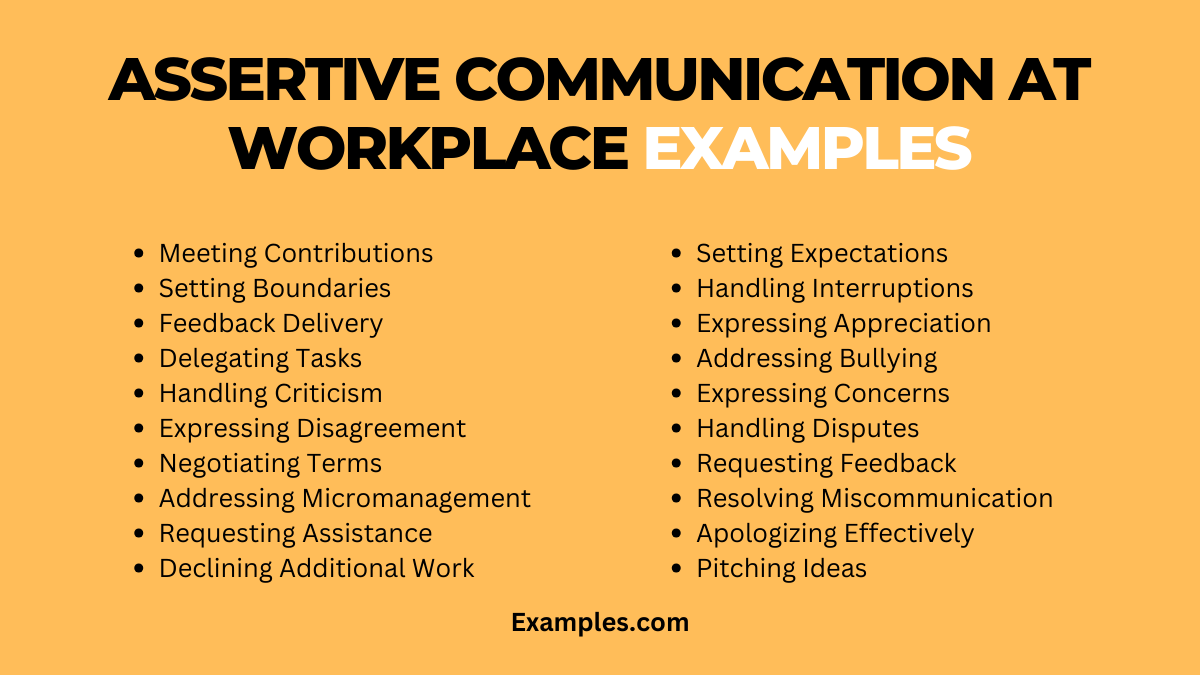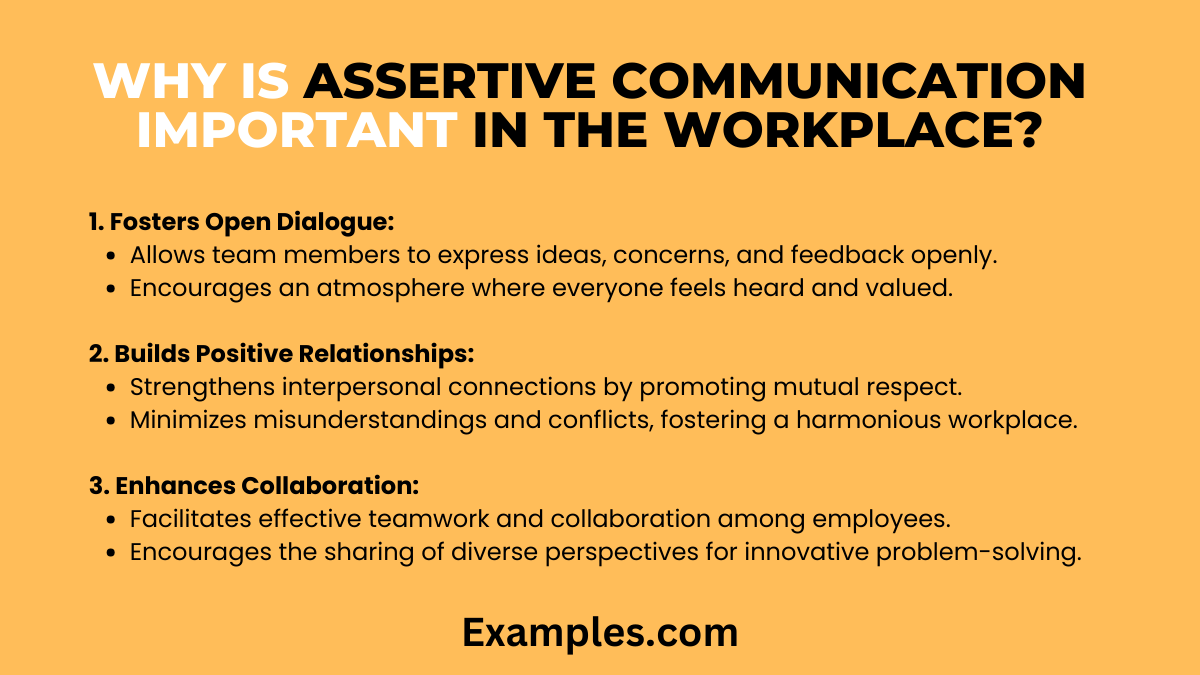19+ Assertive Communication at Workplace Examples
Unlock the keys to professional success with our complete guide on Assertive Communication at Workplace. Mastering this crucial skill fosters a positive environment and enhances collaboration. Learn through vivid Communication Examples that illustrate the power of assertiveness in diverse workplace scenarios. From effective interpersonal connections to conflict resolution, this comprehensive guide empowers you with practical insights. Elevate your communication skills, navigate challenges seamlessly, and propel your career forward with our expert tips and real-world examples. Discover the art of assertive communication for lasting workplace impact.
What is Assertive Communication at Workplace?

In the dynamic realm of professional interactions, Assertive Communication at the workplace stands out as a vital skill. This communication style is characterized by expressing thoughts, needs, and opinions clearly and respectfully, fostering a healthy work environment. It goes beyond passive or aggressive approaches, promoting open dialogue and understanding. Assertive communicators strike a balance, valuing their own perspectives while acknowledging others. Embracing this approach cultivates effective collaboration, enhances team dynamics, and contributes to overall workplace success.
20 Assertive Communication at Workplace Examples

Unlock the art of assertive communication with our curated list of 20 workplace examples. These scenarios showcase the power of expressing thoughts and needs confidently while respecting others.
- Meeting Contributions: In team meetings, boldly share your ideas to contribute meaningfully to discussions.
- Setting Boundaries: Politely but firmly communicate limits to maintain a healthy work-life balance.
- Feedback Delivery: Provide constructive feedback with clarity, emphasizing growth opportunities.
- Delegating Tasks: Assertively delegate tasks, ensuring responsibilities align with team members’ strengths.
- Handling Criticism: Respond confidently to criticism, focusing on constructive improvement.
- Expressing Disagreement: Diplomatically voice dissenting opinions, fostering diverse perspectives.
- Negotiating Terms: Negotiate project terms assertively, ensuring fair agreements for all parties.
- Addressing Micromanagement: Communicate the need for autonomy while updating on progress regularly.
- Requesting Assistance: Ask for help confidently when needed, fostering a collaborative atmosphere.
- Declining Additional Work: Politely decline additional tasks when workload is at capacity.
- Setting Expectations: Clearly communicate expectations to avoid misunderstandings.
- Handling Interruptions: Politely but assertively address interruptions, ensuring focus on tasks.
- Expressing Appreciation: Confidently express gratitude for team efforts, boosting morale.
- Apologizing Effectively: Apologize sincerely when necessary, taking responsibility for actions.
- Addressing Bullying: Confront workplace bullying assertively, seeking resolution through communication.
- Expressing Concerns: Address concerns openly in team discussions, promoting a problem-solving approach.
- Pitching Ideas: Assertively present innovative ideas, showcasing their potential impact.
- Handling Disputes: Mediate disputes assertively, encouraging compromise and resolution.
- Requesting Feedback: Seek constructive feedback confidently for continuous personal and professional growth.
- Resolving Miscommunication: Clarify misunderstandings promptly, preventing escalation.
Assertive Communication at Workplace For Employees Examples
Empower your team with assertive communication examples tailored for employees. From navigating office dynamics to fostering collaboration, these real-world scenarios showcase the effectiveness of confident expression.
- Requesting Flexibility: When needing a schedule adjustment, boldly express your request, emphasizing how it benefits both you and the team.
- Declining Additional Workload: Politely decline extra tasks when overloaded, prioritizing existing responsibilities to maintain high-quality work.
- Collaborating on Projects: When assigned a group project, assertively contribute ideas, ensuring your input positively impacts the final outcome.
- Addressing Unfair Treatment: If facing unfair treatment, communicate your concerns to higher-ups, seeking resolution while maintaining professionalism.
- Presenting Innovative Ideas: Boldly pitch creative solutions during brainstorming sessions, showcasing your commitment to team success.
- Handling Workplace Criticism: Respond to criticism confidently, expressing openness to feedback while defending your perspective when necessary.
- Clarifying Misunderstandings: When misunderstandings arise, address them promptly and directly, preventing potential conflicts.
- Negotiating Benefits: Assertively negotiate for fair benefits, showcasing the value you bring to the organization and industry standards.
- Expressing Career Goals: Communicate your career aspirations clearly, seeking mentorship and opportunities for growth within the company.
- Providing Feedback to Peers: When offering constructive feedback to peers, do so tactfully, focusing on collaborative improvement rather than criticism.
Assertive Communication at Workplace For Teachers Examples
For educators navigating the complexities of the classroom, assertive communication is key. Explore these teacher-specific examples to foster a positive and effective teaching environment.
- Addressing Disruptive Behavior: Assertively address disruptive behavior, setting clear expectations for a respectful and focused learning environment.
- Communicating Lesson Changes: Boldly communicate any changes to the lesson plan, ensuring students are informed and engaged in the learning process.
- Collaborating with Colleagues: When working with fellow teachers, assertively share ideas and collaborate to create a well-rounded educational experience for students.
- Handling Parent-Teacher Meetings: Navigate parent-teacher meetings confidently, communicating student progress and addressing concerns with professionalism.
- Setting Classroom Rules: Clearly communicate and enforce classroom rules, fostering a positive and structured learning environment.
- Addressing Student Challenges: When students face challenges, express empathy and offer support, creating a safe space for open communication.
- Requesting Professional Development: Boldly request professional development opportunities, showcasing a commitment to continuous improvement in teaching methods.
- Adapting Teaching Styles: Assertively adapt teaching styles to cater to diverse learning needs, ensuring every student has an equal chance to excel.
- Seeking Resources: Communicate resource needs to the administration, ensuring access to materials that enhance the quality of education provided.
- Encouraging Student Participation: Foster a participative atmosphere by encouraging students to express their thoughts and opinions confidently.
How Does Assertive Communication Style Help in the Workplace?
Assertive communication is a powerful tool that contributes significantly to a positive and productive work environment. Here’s a comprehensive guide outlining the various ways in which adopting an assertive communication style benefits the workplace:
- Fosters Open Dialogue:
- Assertiveness encourages open and honest communication among team members.
- Team members feel comfortable expressing their thoughts, ideas, and concerns without fear of judgment.
- Strengthens Interpersonal Relationships:
- Assertive communicators build stronger interpersonal relationships by expressing themselves clearly and respectfully.
- Trust and mutual understanding thrive, creating a cohesive and collaborative team.
- Enhances Team Dynamics:
- Assertive team members contribute confidently to discussions and projects, adding value to overall team dynamics.
- Collaboration becomes more effective, leading to improved outcomes and project success.
- Reduces Conflict and Misunderstandings:
- Clear expression of thoughts minimizes misunderstandings and reduces the likelihood of conflicts arising.
- Assertive communicators address issues promptly, preventing escalation.
- Promotes Respectful Behavior:
- Adopting an assertive communication style sets a standard for respectful and considerate interactions.
- Team members learn to express themselves without resorting to aggression or passivity.
- Encourages Feedback Culture:
- Assertive communication promotes a culture of constructive feedback.
- Team members feel confident providing and receiving feedback, fostering continuous improvement.
- Boosts Confidence and Self-Esteem:
- Individuals practicing assertive communication develop higher self-esteem and confidence.
- This positively influences their professional growth and contributions to the workplace.
- Facilitates Effective Decision-Making:
- Assertive team members actively participate in decision-making processes.
- Diverse perspectives are considered, leading to well-informed and strategic decisions.
Why Is Assertive Communication Important in the Workplace?

Assertive communication is a cornerstone of a healthy and productive workplace environment. Its significance extends across various aspects of professional life, contributing to overall success and employee well-being. Here’s a comprehensive guide outlining the key reasons why assertive communication is crucial in the workplace:
- Fosters Open Dialogue:
- Allows team members to express ideas, concerns, and feedback openly.
- Encourages an atmosphere where everyone feels heard and valued.
- Builds Positive Relationships:
- Strengthens interpersonal connections by promoting mutual respect.
- Minimizes misunderstandings and conflicts, fostering a harmonious workplace.
- Enhances Collaboration:
- Facilitates effective teamwork and collaboration among employees.
- Encourages the sharing of diverse perspectives for innovative problem-solving.
- Promotes a Healthy Work Environment:
- Contributes to a positive and inclusive workplace culture.
- Reduces stress and tension, creating a conducive atmosphere for productivity.
- Boosts Confidence and Morale:
- Empowers individuals to express themselves confidently.
- Enhances self-esteem and morale among team members.
- Improves Decision-Making:
- Facilitates clear and concise communication of ideas and opinions.
- Streamlines the decision-making process by ensuring all relevant information is shared.
- Prevents Miscommunication:
- Minimizes the risk of misunderstandings and misinterpretations.
- Promotes clarity in conveying expectations, instructions, and information.
- Resolves Conflicts Effectively:
- Equips individuals with the skills to address and resolve conflicts assertively.
- Prevents escalation of disputes by encouraging open and respectful communication.
Tips for Effective Assertive Communication at Workplace
Mastering assertive communication is a skill that can be honed with strategic tips and practices.
- Clarity and Confidence: Clearly express your thoughts with confidence, ensuring your message is understood by others.
- Active Listening: Practice active listening to understand colleagues’ perspectives, fostering empathy and collaboration.
- Use “I” Statements: Frame statements using “I” to express feelings or opinions without sounding accusatory, promoting a non-confrontational tone.
- Set Boundaries: Clearly define personal and professional boundaries, ensuring a healthy work-life balance.
- Choose the Right Time: Pick appropriate moments to communicate assertively, avoiding disruptions and distractions.
- Positive Body Language: Enhance verbal communication with positive body language, conveying openness and receptiveness.
- Conflict Resolution: Approach conflicts assertively, focusing on finding solutions and common ground.
- Receive Feedback Gracefully: Embrace feedback with grace, viewing it as an opportunity for growth and improvement.
- Maintain Respect: Communicate assertively while respecting the opinions and perspectives of others.
- Continuous Improvement: Regularly assess and refine your assertive communication skills, adapting them to evolving workplace dynamics.
By incorporating these tips into your communication style, you can enhance assertiveness, contribute to a positive workplace culture, and navigate professional interactions with confidence.
In conclusion, assertive communication at the workplace is a pivotal skill that not only enhances individual performance but also contributes significantly to creating a healthy and productive work environment. It balances the expression of personal thoughts and needs with respect for others, fostering open dialogue, strengthening interpersonal relationships, and promoting effective collaboration. The benefits of assertive communication are manifold, including fostering open dialogue, building positive relationships, enhancing collaboration, promoting a healthy work environment, boosting confidence and morale, improving decision-making, preventing miscommunication, and effectively resolving conflicts.



